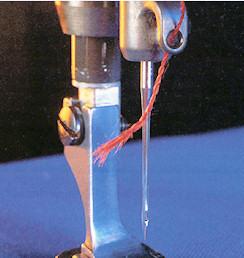Search the Community
Showing results for tags 'tension issues'.
-
Original text by: Marina Belova. The image is the courtesy of. Who likes when a thread breaks when embroidering? Nobody does. That's because filling the gaps takes a lot of time and the end result looks bad. In one of my blog posts I told how to create a design in order to minimize the embroidery thread breakage, and I also wrote that there can be many reasons for it: the design, the materials, the adjustment and the technical state of your embroidery machine. Let's find out who is responsible when the design is correct. First, we should learn if the embroidery thread itself is the reason for the thread breakage. How do we do it? We can replace the bobbin and check how this will affect the performance. This will eliminate poor quality threads. My experience shows that poor quality embroidery threads increase the production time by at least 50%. Also, I've never encountered threads worse that those of Gamma and WonderFil. If that didn't help, you should explore the place where the embroidery thread breaks. It may not look the same: it may appear clean cut, like it was done by scissors, or it may look scruffy. If the embroidery thread is clean cut, it means that the needle is not inserted properly, all the way. It does down too deeply and breaks the thread. The scruffy end shows that the needle is too thick or too thin for this thread or that the shuttle is not adjusted. But the burrs in the throat plate opening or the presser foot also may be the reason. You should examine how the thread is feeding off the bobbin when embroidering. Whether it does not twist or go into loops. The metallic embroidery thread is somewhat notorious for it, and also the bobbins of a household winding, which have a small diameter. If it is the reason, you should cover the bobbin with a net It often happens that the old and dry embroidery threads slip down the bobbin and get stuck at the very bottom, pulling the thread and becoming the main reason for the thread breakage. If the thread is of a poor quality or very old, it should be replaced. If that is possible, of course. You should also check the bobbin. How it is wound, whether it is correctly inserted into bobbin case. Then we check the needle — whether it is sharp enough, does it have burrs and nicks, which may be the reason for the twisting of the thread. Check if the needle is not bent and that is has been placed exactly in the center over the throat plate. Whether is has been inserted correctly (all the way and in the proper position)? Or maybe the needle is too thin for this type of embroidery thread? Sometimes the thread thickness and the size of the needle are not right for the embroidery design of that density. For example, the thread number 40 is best for the design, but you use number 30 and a thicker needle. If the embroidery design has many layers, you should use sharp needles with teflon coating, a bit thicker than the ones that usually go with this type of embroidery thread, in order to prevent the thread breakage. The next step is to check if the threading has been done properly and whether the tension was adjusted. And also to check whether the embroidery thread path is free from lint and dust. Whether the embroidery machine was oiled. Whether the embroidery speed is too high. And whether the shuttle has been adjusted properly (there should be the gap between the flat side of the needle and the point of a hook). If the gap is too small, it may snap the thread. And if it's too big, it may be the reason for the embroidery machine skipping stitches. Another reason for the embroidery thread breakage may be a coarse and densely woven fabric, because the thread frays when going through it. A wrongly chosen stiff and dense stabilizer may cause the same problem. If the item you are embroidering has been hooped incorrectly, i.e. not stretched tightly in the hoop or the frame, there will be fabric flagging, which, too, often is the cause for the thread breakage.
- 1 comment
-
- 3
-

-
- thread breakage
- embroidery
- (and 7 more)


